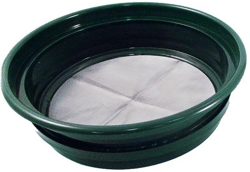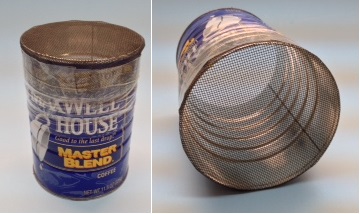“Coconut”: Sifting and Sifters
This article is a supplement to our “Secret of Coconut” article, which describes various ways modern hobbyists have attempted to reproduce a certain kind of fuzzy-looking coating on vintage cardboard Christmas “putz” houses.
Note: These articles are based on notes from a number of putz house builders and restorers who’ve attempted to replicate the original finish to use on their own construction. We’re publishing them because the questions keep coming in. But we did want to point out that none of the people who contributed to the article (including me) have any intention whatsoever to make this stuff to sell commercially - there are a lot of easier ways to make a living, and there’s already a fellow - Pete Oehman, who makes a better product than I ever will. We’ve done our best to give you the information you need to “roll your own,” but if you’d rather finish that structure than learn a new skill, or if you need to match a difficult color, contact Pete through CardboardPutzHouses.com and tell him we sent you.
Most folks today are experimenting with wheat straw that is rough cut, then chopped to size in some sort of blender or food processor or other kitchen device.
Cutting and chopping produce a lot of dust and other waste. Chopping, especially, tends to be an iterative process that one reader describes as “chop, sift, chop sift, chop sift, chop, sift,” etc.
The first few sifts are to get out the dust. As the pieces approach a more consistent size, there will always be some that for whatever reason are a little too big, but overprocessing the whole batch just to get them, too, will just give you more dust. So you filter to get out the big pieces, too, as well as any “twigs and seeds” that have somehow got into the mix.
The good news is that, although its possible to buy commercial products that will help your sifting (and you may want to eventually), you can experiment with remnants of screen or net fabrics for almost nothing. If, after a few batches, you decide that this is really your calling, may certainly spend more money on equipment. But if a few batches is all it takes to convince you you’d rather buy it from now on, you haven’t invested the cost of a whole towns’ worth of houses into something you’ll never use again.
Sifting for Dust
One reader uses a kitchen flour sifter to sift out dust, especially during pauses in the “blender dance.” The same reader has also experimented with using window screening or various nylon fabrics (such as nylon hose material) duct-taped to one end of a coffee can with both ends cut out.
I’m told that a 30-mesh commercial screen  - used for grading “gold dust” or the like - is said to be the “right size” for this. - used for grading “gold dust” or the like - is said to be the “right size” for this.
Sifting for Oversized Bits
You’ll also need to sift out the oversize bits, once the average fragment size in the batch is about what you want. You may get out enough to justify another trip to the blender, but there comes a point where running the whole batch through again just to catch a handful of oversize pieces winds up turning good pieces to dust, and not benefiting you in the long run.
A 70-mesh commercial screen  - used for grading “gold dust” or the like - is said to be the “right - used for grading “gold dust” or the like - is said to be the “right  size” for this. size” for this.
Note: If you buy both the 30 mesh and 70 mess commercial screens, you can stack them (the 70 on top). Then you can sift the dust and oversize pieces out at the same time. The dust goes in the trash, and the oversize pieces go back in the blender or whatever you’re using to chop. Of course you may want to save your money at first and see how you like the rest of the process before you invest in these.
Home-Made Sifters
 It’s also possible to make your own sifters by attaching the filtering material of your choice to a coffee-can with duct or packing tape. For a filter that lets dust pass through, but holds the “keeper” stuff in, you might try nylon window screen material. It’s also possible to make your own sifters by attaching the filtering material of your choice to a coffee-can with duct or packing tape. For a filter that lets dust pass through, but holds the “keeper” stuff in, you might try nylon window screen material.
For a sifter that lets “right-size” stuff pass but gets rid of oversize pieces, try a remnant piece of “tulle” or other fine nylon netting, then duct-taping it to the bottom of a coffee can with both ends removed. You’ve seen tulle - it’s that light netting used in bridal veils, tutus, pageant-dress petticoats and the like. A few inches is all you need so if someone in your family sews, they may already have some.
If your tulle filter winds up letting bigger pieces than you’d like through, you can always try doubling the tulle - doubling it up with effectively reduce the size of the holes.
Experiment
There is no one right way to do this. So if you want to try sifters and strainers you have around the house, or use some other fabric or screen material for your home-made screens, or buy some other commercial product, that’s fine. The end result is that you should have a bunch of little pieces about the same size, with the dust sifted out.
Conclusion
You may get tired of sifting, but it’s an essential part of the process. We have no idea if the original Japanese putz house builders figured out a “workaround” for this, but so far, our readers’ experiments have all prominently featured this aspect of the process, multiple times. In fact, you’re not done sifting until after the next two steps: dyeing (or bleaching) and drying. But this is part of the attention to detail that will make your coconut a believable replacement for the vintage original.
If you’re looking for one good proven method that will work for everybody, this may not be what you were looking for. But so far there’s not single “best practice” that works for everybody, regardless of their skills, interests, and resources.
In other words “Do try this at home.” And when you do, feel free to report your results on the Coconut page of our forums.
In the meantime, I look forward to hearing and seeing the results of your experiments, with this or any other aspects of putz collecting, displaying, restoring, or creating.
Paul Race
CardboardChristmas.com


|